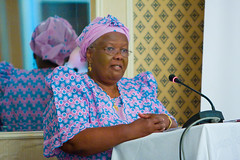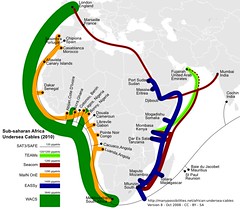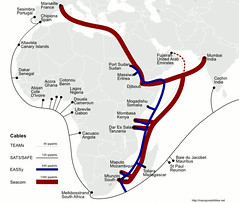Blogs
-
ICASA - Stealing from AIDS Orphans
So, I’ve moved on from righteous indignation yesterday to outright disbelief today. News this week that the South African communications regulator (ICASA) have sent their enforcers in to confiscate Dabba’s WiFi equipment in Orange Farm makes me angry enough to spit.
-
I am filled today, as is often enough the case these days, with a sense of righteous indignation. In a meeting earlier today, Dominic Cull (firebrand lawyer for the forces of telecommunications good in South Africa) pointed out the obvious. He said that one of the single most important things mobile operators could do to make a difference for the poor would be to drop the price of SMS charges. The funny thing about the obvious is that we often don’t see what is staring us in the face.
-
Undersea Cables Update
It has been a busy year in the world of African undersea cables as the timeline below of cable maps over the last year will attest. A lot has happened or more accurately plans and announcements for a lot have happened.
-
Good Evolution, Bad Evolution
This post is a little off-piste for me but what is blogging for, if not to occasionally skate on or over the edges of one’s knowledge. This month is the 200th anniversary of the birth of Charles Darwin and the web is awash in articles about Darwin and the theory of evolution. Having read many of these articles, I have now come to agree with the New Scientist’s introduction to 24 Myths About Evolution when they say If you think you understand it, you don’t know nearly enough about it.
-
The Yin and Yang of Open
In Eric Beinhocker’s The Origin of Wealth, he describes a fascinating software experiment modeling the prisoner’s dilemma but not between two decision-makers (as in the classical scenario) but rather in a multi-actor evolutionary landscape in which anyone can make a transaction with anyone. The software was used to seed open and closed transaction strategies into an evolutionary landscape. The interesting result is that “open” strategies succeed very well in a very closed ecology and “closed” strategies succeed very well in a very in a very open environment. In this perspective, the whole current movement in favour of “open” might be seen simply as a rebalancing of a very closed economic ecosystem.
-
I admit to being a little gobstopped by Nicholas Negroponte’s announcment in the Guardian that the next generation OLPC will be Open Hardware is a pretty big deal. I picked up the announcement this morning from Make Magazine editor, Phil Torrone’s twitter feed in which he says “This is pretty much the biggest news of 2009″. For the maker, tinkerer, hardware hacker world, this might just be true.
-
Action Talks, Armchair Pundits Walk
It is remarkable how polarised the discussion of the OLPC has become. You either love it or hate it. I have already said my own say about the value of the OLPC but there is one point that I don’t think has been emphasised enough.
-
Annotate-ipedia
Have you ever purchased a book in a second hand book store and found when you got home that the margins of the pages were crammed with annotations? A bit like the page from James Joyce’s Ulysses at the right. Some may be irritated by the spoiling of a pristine printed page but I confess to a minor voyeuristic thrill at the prospect of looking at the book through someone else’s eyes. Looking at the text through someone else’s eyes actually makes your relationship to the book more complex. There are two stories now, the one you created by reading the story and the one that the mysterious annotater created.
-
Climate Change as Terrorist Threat
Harvard professor of psychology Dan Gilbert gave an inspired talk at Pop!Tech this year in which he asks the question “Why haven’t we rallied our collective power to solve global warning?” In it, he argues that global warming is not the kind of threat that humans are programmed to respond to. Like the boiling frog parable, we simply aren’t designed to recognise global warming as life threatening in the way that we do with “fight or flight” threats. This made sense and was a bit of a revelation to me.
-
Mobiles versus Laptops
Cory Doctorow is one of my heroes. A great writer, an outspoken champion of the commons, and someone who is not afraid to be himself in public. I have relied on his ideas countless times in my own work. It is therefore a bit of a surprise to see him drop a clanger in the Guardian a couple of days ago. In his article, Laptops, not mobile phones, are the means to liberate the developing world, he emphasises the difference between mobiles and laptops when we ought to be focusing on their convergence. He laments the recent downsizing of the OLPC project and defends its aims. Further he predicts its ultimate success or at least the ultimate success of “laptops for Africa” when he says “I believe that laptop computers will eventually find their way into the hands of practically every child in the developing world.”
-
South Africa, which recently made a great leap forward in the opening up of competition in the telecommunications is in danger of making an even bigger leap backwards thanks to the license fees being proposed by ICASA. ICASA has proposed that operators possessing an I-ECNS license pay 3% of gross income as a fee. The I-ECNS license is what is required to be a national infrastructure operator e.g. Telkom, MTN, Vodacom, et al and hopefully soon some new entrants. ICASA has further proposed that holders of an I-ECS also pay 3% of gross revenue. I-ECS licenses apply to anyone delivering electronic services e.g ISPs nationally in South Africa. Thus, companies providing both infrastructure and services nationally will be obliged to pay 6% of their gross revenue as a license fee.
-
7 Things You May or May Not Know About Me
Tagged by the fearless and gregarious Mark Surman, I semi-reluctantly allow myself to become a vector for the 7 things meme/social virus. I suspect Patient Zero to be a Mozillian. So here are…. 7 things about me:
-
Why WiFi in Africa?
Imagine an alternative history. Imagine that in 1995, when Microsoft launched their walled-garden MSN service, which they fully expected would, for all intents and purposes, put the Internet out of business, imagine that they succeeded.
-
YAPAUC - Africa Coast to Europe (ACE) Cable

-
The Rationality of Mobile Spending
Richard Heeks has written an interesting post entitled Mobiles for Impoverishment in which he says that recent m4d research “suggests mobiles are doing more economic harm than good, and sometimes making poor people poorer”. He points to quantitative and qualitative research that suggest that economic benefits are not being realised by the users of mobile phones in poor countries. The full post is well worth reading. In the end, he draws two conclusions: 1) that if significant value is being spent by the poor on phones, then they must be deriving significant value; and 2) that financial gain is not the only benefit that the poor derive from mobile phones.
-
The Birthday Innovation or Why Blog?
I think there is a compelling reason why everyone ought to blog/tweet/social network or leave some sort of digital trail. As Seth Godin puts it,
-
Wanted: Pirates on the High Seas of Agricultural Research
Reprising a role in a previous life at Bellanet.org, I gave a presentation last wee in Maputo to the Knowledge Sharing (KS) community within the Consultative Group on International Agricultural Research (CGIAR). Actually it started out that way but because the CGIAR’s Annual General Meeting is such a confluence of actors and agendas, the KM workshop was combined with another workshop organised by the Global Forum on Agricultural Research (GFAR) and the Commonwealth of Learning (CoL) focused on agricultural education and farmer to farmer learning through collaboration.
-

-

-
Ethan Zuckerman has been writing about Innovating from Constraint in which he offers seven rules that “appear to help explain how (some) developing world innovation proceeds”. This post was riffed on beautifully by Design in Africa prompting Ethan to produce an extended dance mix version of his post. All of the above are well worth the read.
-

-
South Africa Connect Launches

-

Minister Matsepe-Casaburri courtesy kjd
-

-

-
As I am getting my head around spectrum issues, I have found Michael Marcus’s blog, Spectrum Talk, tremendously useful. On the weekend he posted a link to a consultation that Ofcom (the UK communications regulator) have launched consultation on the possibility of of making license-exempt the bandwidth between 275GHz and 3000GH.
-
It’s time to get down to business and start developing a civil society position on spectrum management in South Africa. The key purpose of spectrum management is to maximise the value that society gains from the radio spectrum. That has traditionally been done in a command-and-control manner treating spectrum as a completely finite, scarce resource. But things are changing.
-
The undersea cable environment around the African continent continues to evolve. Proposed cables appear, disappear, merge. A testament to the competitive environment. In this latest update, I have added the MaIN OnE cable which appears to be making progress. Thanks to Abi Jagun for finding their real website.
-

-
Inspired by Rudoph Van Den Burg’s riff on Jeremy Clarkson’s TopGear Cool Wall I thought a Cool Wall for the South African telecommunications and Internet community might be fun to do. For those who haven’t seen it, the TopGear Cool Wall ranks automobile coolness on a scale ranging from SubZero to Cool to UnCool to Seriously UnCool. Rudolph Van Den Berg has taken the idea and applied it to European and North American telcos. I think a little local application might be in order. As with TopGear the rating is somewhat subjective and the list non-exhaustive and possibly downright erratic.
-
In a landmark decision today, the High Court of South Africa ruled that everyone in possession of a Value Added Network Service (VANS) license was entitled to “self-provide”. What this means is that every Internet Service Provider (ISP) in South Africa is entitled to compete with the likes of Telkom, Vodacom, MTN, and Neotel. In one fell swoop, the market has gone from 4 players to conceivably over 600 players.
-

-
At the Shuttleworth Foundation we have a now reasonably well-established tradition of gathering together every Tuesday at lunch to watch a Ted Talk. I borrowed this idea from Vera Franz of the Open Society Institute and with only a few damp squibs we have seen some great presentations and had some great discussions as a result.
-
Open Hardware for Development
 In my last post I wrote a bit about what kinds of information and communication technologies are needed by the poor. I have also written about the importance of tinkering and tinkerable technologies as a catalyst for innovation.
In my last post I wrote a bit about what kinds of information and communication technologies are needed by the poor. I have also written about the importance of tinkering and tinkerable technologies as a catalyst for innovation.
-

Nokia 1100 - Courtesy Wikipedia
-
he One Laptop per Child (OLPC) project comes in for a lot of criticism for being, among other things, “centralised and top-down”. Critics also argue that academia and philanthropy should not be interfering in areas where the market is clearly in a better place both to innovate and to sustain new technologies in the marketplace.
-
I had a great conversation with David Carman yesterday who runs a community mesh network in Scarborough (south of Cape Town). We discussed mesh technologies, topologies, and Open Source medical applications but towards the end, the conversation strayed to digital video and security. He told me about a remarkable project in Palestine, called Shooting Back, in which a human rights NGO distributed 100 cameras to palestinian citizens to record human rights abuses. The results are pretty disturbing as this Guardian article testifies but also pretty remarkable. As David put it, often the power of the criminal lies in anonymity. Letting people know that they don’t have the luxury of anonymity can be a powerful incentive for behavioural change.
-
In the development world, getting a project profiled in The Economist is a bit like a rock band being profiled in Rolling Stone. This week’s Economist has a profile of Dabba. Pretty cool.
-
Very excitingly, we hosted the first Village Telco workshop. It exceeded all expectations both in the calibre of the people attending and the very concrete outcomes that emerged. Details of the workshop and its results are on the newly hosted website. One key result of the workshop is a plan to create a new device that merges the functionality of a low-cost mesh access point and an analogue telephony adaptor (ATA).
-
Sub-saharan Africa Undersea Cables in 2010 - maybe
So what might the undersea cable environment for sub-Saharan Africa look like by the end of 2010? Perhaps it will look a bit like this:
-
Dabba wins Social Entrepreneur of the Year Award
Last week in Berlin at a Forum on Social Entrepreneurship hosted by German venture capital company Hasso Plattner Ventures, Rael Lissoos and Dabba won the Social Entrepreneur of the Year 2008 award. The event, sponsored by Deutsches Bank and MAN brought together 250 social entrepreneurs together with investors.
-
The Silence of the Lambdas
I have been gradually getting my head around bandwidth purchasing models for undersea cables. In my second contribution to the Mail & Guardian’s innovative Techleader site, I use a real estate metaphor to contrast the various scenarios.
-
Village Telco Workshop
At the Shuttleworth Foundation, the geek factor runs pretty high for a charitable foundation. However, my colleague Jason and I felt like lightweights at the the Village Telco workshop that we hosted here at the Foundation two weeks ago.
-
A talk worth watching is Paul Collier’s heartfelt presentation at the TED event earlier this year. He talks a bit about his book The Bottom Billion which, as a non-economist, I am finding both insightful and accessible.
-
On Wednesday this week, the City of Cape Town made the final approval to launch its ground-breaking municipal Broadband Infrastructure Project.
-
The Guardian this week published a review of Jonathan Zittrain’s book “The Future of the Internet and How to Stop It.” The journalist quotes Zittrain as saying
-
Bill St. Arnaud points out that Pipe International, who are building an undersea cable from Sydney to Guam, have taken a completely transparent approach to communicating about project development and progress. Even to the point of having dynamic online maps of cable development.
-
Here is a short note on where things stand with Dabba and the Village Telco. The Shuttleworth Foundation is planning to fund the hacking/adaptation/development, to at least alpha version, of an Open Source “Village Telco” integrated suite of applications.
-
In an earlier post, I wrote about a very cool publishing model used by a bible publishing company in the U.S.
-
On the 27th of February 2008, the Department of Communications published a notice inviting comments on Proposed Guidelines For Rapid Deployment of Electronic Communications Facilities in Terms of the Electronic Communications ACT, 2005 (ACT NO.
-
File this one under thinking out loud but why isn’t there a commons for ideas? For example, if I came up with a useful workshop facilitation methodology, I would share it. However, if I knew that I was likely to be given credit anytime anyone used it, I would probably share more enthusiastically and maybe even put more effort into polishing the methodology for use by others.
-
I lurk on one of the more interesting mailinglists in the world. act-KM, originally an Australian but now global community of practice on Knowledge Management or since I abhor the term Knowledge Management, let’s say on the nature of knowledge in general and how to make it grow and flow in and across organisations. It is a high traffic list and not a very peaceful one. The debate rages (I choose the adjective carefully) between academics, practitioners, corporate hacks, and grass-roots types. It is not always kind and at times I find some of the sniping simply unpleasant. However, that is substantially outweighed by the calibre of discussion. It is a privilege to hear the likes of Dave Snowden, Steve Denning, Patrick Lambe (to name just a few) hashing issues out in a community space.
-
 Having decided to help Dabba explore the replication of their Orange Farm success down here in the Western Cape, it was not immediately clear to me how to go about finding the right place for such a project. Alan Levine of Vanilla (Dabba’s partner in the Cape) initially provided a connection to a local NGO working with schools to provide support services to children affected by HIV to enter formal schooling with the necessary skills. However, after visiting the NGO sites, it was evident that while there was interest in the Village Telco concept, technology and entrepreneurship were not their sweet spot. They could see the value and would make great clients but were not the sort of organisation to drive an idea like this.
Having decided to help Dabba explore the replication of their Orange Farm success down here in the Western Cape, it was not immediately clear to me how to go about finding the right place for such a project. Alan Levine of Vanilla (Dabba’s partner in the Cape) initially provided a connection to a local NGO working with schools to provide support services to children affected by HIV to enter formal schooling with the necessary skills. However, after visiting the NGO sites, it was evident that while there was interest in the Village Telco concept, technology and entrepreneurship were not their sweet spot. They could see the value and would make great clients but were not the sort of organisation to drive an idea like this.
-
The Economic Value of Taking Things Apart
In the Concise Encyclopedia of Economics, Paul Romer writes:
-
Dabba relies on a variety of Open Source software application to enable their network. Here is a profile of some of those applications.
-
Business Day Africa profiles the Communications Commission of Kenya’s decision to offer ISM-band spectrum to non-profits:
-
Reading the tech news in South Africa, you get the impression that WiMax is going to very shortly solve all of the country’s broadband issues. Articles like this one give the impression that WiMax will shortly be available in every major city in South Africa. Municipal WiMax enthusiasts argue that this is “no business case for WiFi”
-

 The conventional wisdom in the ICT4D community is that people in developing countries spend a higher percentage of their income on communications than the global average. For South Africa, this notion became is widely accepted (I think) thanks to the Vodafone study on mobile usage, in which Diane Coyle of Enlighenment Economics says:
The conventional wisdom in the ICT4D community is that people in developing countries spend a higher percentage of their income on communications than the global average. For South Africa, this notion became is widely accepted (I think) thanks to the Vodafone study on mobile usage, in which Diane Coyle of Enlighenment Economics says:
-
 Meet Rael Lissoos, a economist turned geek entrepreneur. While I have been talking about Village Telcos, Rael has been out building one in Orange Farm, a township about an hour south of Johannesburg.
Meet Rael Lissoos, a economist turned geek entrepreneur. While I have been talking about Village Telcos, Rael has been out building one in Orange Farm, a township about an hour south of Johannesburg.
-
 Earlier this week I came across this wonderful master’s thesis entitled Generation of Complex Diagrams: How to Make Lasagna Instead of Spaghetti by Noah Iliinsky. We have all at various times had our minds numbed by needlessly complex diagrams that did more to obscure the issue than explain it. This is the first insightful analysis I have seen about what makes a good or bad diagram. Well written and with many excellent examples of great and awful diagrams.
Earlier this week I came across this wonderful master’s thesis entitled Generation of Complex Diagrams: How to Make Lasagna Instead of Spaghetti by Noah Iliinsky. We have all at various times had our minds numbed by needlessly complex diagrams that did more to obscure the issue than explain it. This is the first insightful analysis I have seen about what makes a good or bad diagram. Well written and with many excellent examples of great and awful diagrams.
-
Seacom has emerged as a clear front runner in the African undersea cable stakes. They are the first initiative to declare a completion date, 17 June 2009 (after which cable company Tyco will incur performance penalties). More impressively they have revealed their wholesale pricing scheme which looks like this:
-
Tim O’Reilly points out some very cool publishing models being used by Logos Bible Software. The have a pre-publishing service in which clients commit to order at a discount in exchange for placing a pre-order for a specific product and Logos can guarantee that there costs are covered. Each potential pre-publish book has a meter which displays the current level of pre-orders.
-
 In the spirit of the previous post consolidating information on African undersea cables, I compiled the image at the right to create a consolidated picture of existing and future cable initiatives around the continent. The relative cable sizes are roughly to scale according to the advertised capacity of the cables. There is certainly a contrast between the various initiatives.
In the spirit of the previous post consolidating information on African undersea cables, I compiled the image at the right to create a consolidated picture of existing and future cable initiatives around the continent. The relative cable sizes are roughly to scale according to the advertised capacity of the cables. There is certainly a contrast between the various initiatives.
-
As Mark Twain once said, “reports of my death were great exaggerated”. This could be very aptly applied to the optimistic perception that the Internet and cheap telecommunications meant that it didn’t matter where you were, the so-called “death of geography”. The future was in telework and invisible global supply chains. While there is truth to the flat world notion popularised by Thomas Friedman, it is equally true that “local” has become more important than ever. Strangely the more connected we become, the more local seems to matter.
-
“…broadband thrives on a mix of competition and active regulation, to ensure an open context.” This succinct summation comes from an Economist article from a couple of weeks ago entitled “Open up those highways“.
-
Having funded and watched and occasionally participated in the wireless hacker space in Africa for the last few years, I have the sense of “waiting for the next leap forward”. Wireless hackers have been successfully building cantennas, woktennas, and waterbottletennas, to name a few. They’ve been flashing Linksys Routers with a variety of free firmware replacements and in general tinkering with WiFi in a very cool way. I say cool because I think tinkering is one of the best ways of learning about something and also because taking something apart is a way of demystifying technology and ultimately making it something that serves you as opposed to the other way around.
-
Mostly in order to keep them all straight in my head, I have compiled a list of African undersea cable initiatives and their features, investors, etc.